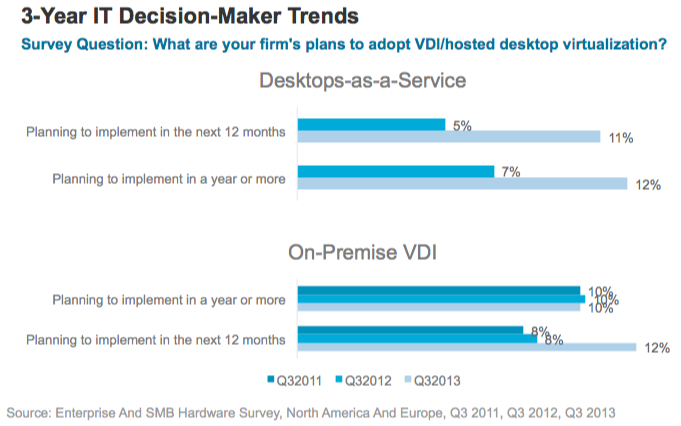VMware Buys Desktone as the Desktop-as-a-Service Market Heats Up
VMware Acquires Desktone. What does it Mean?
In Barcelona this week, VMware announced that it is acquiring Desktops-as-a-Service provider, Desktone. This is a market I've been watching for several years, and I think this is good news for both Desktone and VMware customers. On one hand it provides an alternative for VMware prospects who are unsure whether they want to make the investment in ramping up an in-house VDI initiative, and it provides a scale-out option for existing VMware View customers who may be loathe to make additional capital investments to expand their capacity. With Citrix also developing their own homegrown DaaS infrastructure offering for service providers, this move further legitimizes the DaaS market.
Forrester has been tracking the rise in interest in DaaS specifically in our Forrsights surveys of IT decision makers for the past 2 years, which gives us a unique view into the market. In Figure 1 below, we can see the rise in IT decision-maker interest in DaaS relative to on-premise hosted virtual desktops, and see that year-over-year growth of DaaS interest is strong. The market accelerated in part because Infrastructure-as-a-Service providers see it as a way to monetize their existing infrastructure investments.

What is DaaS exactly?
This is a hot debate within the industry, but Forrester's view is that the term DaaS should only apply to desktops as a hosted cloud service, and conform to Forrester's guidance for what is and is not a cloud service: A standardized IT capability (services, software, or infrastructure) delivered in a pay-per-use, self-service way. Standardization means that the provider offers the service in the same way every time a customer requests it. This does not preclude choice or variance in configuration but standard operating procedures for at least the provisioning and life-cycle management functions. Pay-per-use means that the public cloud solution must track the use of virtual resources so central accounting can be used to charge back for their consumption. Self-service means providing either a client-facing portal or an administration tool through which end customers — IT Admins in most cases — can self-request and manage resources and have those commands automatically acted upon.
DaaS Economics are a Significant Challenge
DaaS economics are a challenge for service providers because their customers tend to compare the cost of DaaS with what it currently costs them to deploy and maintain physical PCs through their lifecycles. When customers shift to a hosted service for desktops, the user experience becomes paramount and requires optimizing different parts of the technology stack versus, say, a web server. Taking out the substantial cost of a Windows desktop license for a moment (a significant barrier to DaaS adoption), keeping costs down and the user experience high requires an infrastructure that is both optimized for Windows desktop performance (e.g. adequate personal storage, storage IOPS performance optimized for desktop application uses, fast boot, etc.) but is also fully automated through the entire customer on-boarding and desktop instance life-cycle, from creation to archiving or deletion – including scaling up performance, fail-over, full multi-tenancy etc. This is very hard to achieve and still fit within the existing portals and frameworks of service providers.
Desktone's Platform is its Differentiator and Improves DaaS Economics
Desktone's platform architecture is the result of several years' worth of engineering effort specifically toward the challenges of delivering full Windows desktops, session-based desktops and applications on-demand, cost effectively. Their business centers on enabling service providers to offer Desktops-as-a-Service, including the platform technology itself, blueprint reference architectures and cleverly, go-to-market and lead-gen materials for service providers as well. Key partnerships include Cisco, NetApp and GreenBytes for specific underlying elements, and Desktone's reference architecture has included the VMware hypervisor and integration with PCoverIP for some time, making it a more natural fit for service providers already using it and any of their their prospects already using thin client hardware optimized for VMware View. All of this allows Desktone to boast that their platform can serve up DaaS for a claimed 30-40% less than traditional VMware or Citrix architectures not specifically designed for service provider applications.
Desktone Fills a Hole in VMware's Portfolio
VMware's chief competition in the desktop virtualization market remains Citrix, and Citrix has been working for some time on a homegrown solution based on XenDesktop and CloudStack called Project Avalon. Citrix has always had core strengths in user experience, so when clients ask me which VDI solution I recommend for things like high-end graphics design and engineering for example, I often recommend Citrix because of the way the HDX system works and its reputation for very good performance and usability over a wide range of conditions and use cases. Because user experience is paramount for service providers to succeed with DaaS, Citrix is a compelling choice. Until now, VMware didn't really have an answer to Citrix's strategy, so Desktone launches them into the service provider market with a proven platform.
If You're Considering VDI, it's Time to Consider DaaS as Well
With "don't own stuff" becoming the credo of more and more CIOs, DaaS turns what would otherwise be a big CapEx and eye-watering OpEx initiative over several years for a traditional VDI approach into a purely OpEx initiative. It's not cheap with Windows desktop instances hovering around $25-30 USD per month on the low end to more than $80 per month on the high end (depending on storage, CPU and memory allocation, and any extra apps and management services), but with the role of the Windows desktop changing for more and more workers, it's a price more firms are willing to pay and we expect economies of scale and the effects of competition to continue to chip away at the cost.
Workstyle Flexibility, Device Freedom, Security and Compliance are the Chief Advantages
As with both VDI and shared server-based computing models, with DaaS you can give the workers in your firm the freedom to choose different computers and devices, such as Macs, Windows 8.x tablets, convertibles or even iPads yet still have access to a managed Windows desktop environment when necessary. With many service providers now offering PCI or HIPAA compliance certifications for their datacenters, DaaS can be a realistic way to unlock the potential of BYOD, while keeping the auditors and bureaucrats at bay. One university I spoke with recently got themselves out of the student PC/Mac support business by providing DaaS instances for students to use when they need to get access to the university network and private systems of record behind the firewall.
The Desktone Acquisition Legitimizes Other Providers and Sets the Stage for More Competition
Desktone and Citrix are by no means the only vendors in the DaaS space. tuCloud, DinCloud and LeoStream have been in the DaaS infrastructure market for a while and are worth investigating. And while we have no specific knowledge of Microsoft's plans, we hope to see them in the DaaS business both as a service provider and a provider of service provider infrastructures for DaaS within the next 12-24 months given that they hold the strings for the Windows desktop licensing model, and the natural affinities between Windows Azure, Server 2012, Hyper-V and the Windows desktop experience. Microsoft is in an excellent position to deliver new desktop and app experiences from the cloud, so we'll be excited to see what's on the horizon as they reveal more plans.
